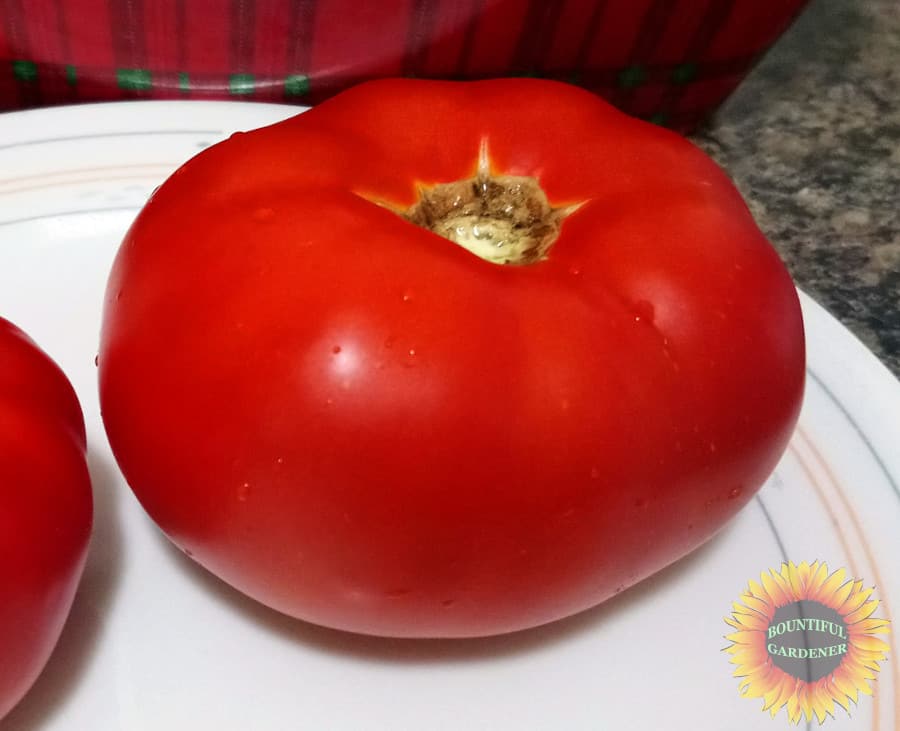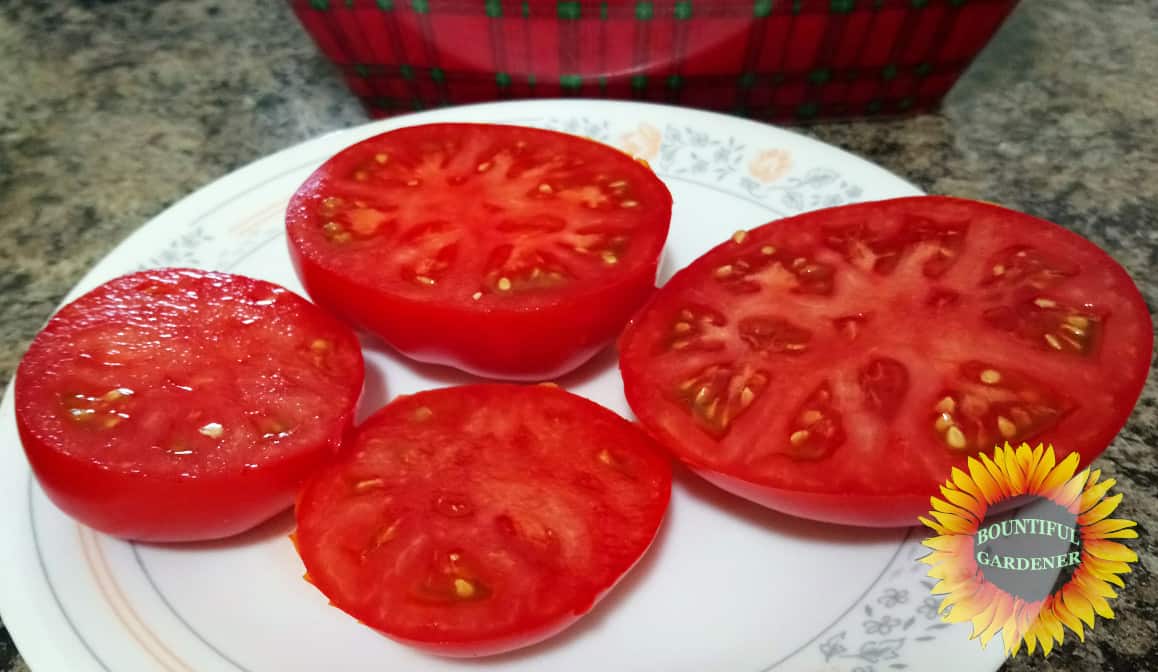When you dive into the world of dwarf tomatoes, you’ll find a plethora of choices of what to grow. Although their popularity is growing, these are still relatively niche varieties and it’s difficult to find recommendations. But one variety every gardener needs to try is Sweet Scarlet.
Sweet Scarlet is one of the Dwarf Tomato Project varieties which has been praised by the community for producing high yields of richly flavored tomatoes. Not only that, but Sweet Scarlet produces full-sized, medium-to-large red tomatoes on a dwarf bush. Read more to learn all about this variety, how to grow it, and where to find seeds.
On this page:
Profile: Sweet Scarlet Dwarf Tomato
A heavy-yielding dwarf variety that produces vibrant, scarlet fruits
Days to Maturity: 75 to 90 days
Type: Dwarf, potato leaves
Tomato Size and Shape: 6 to 16 oz (medium-large), oblate-shaped, slightly ribbed
Plant Height: 3+ feet
Open Pollinated? Yes
Get seeds: Victory Seeds (US), TomatoFest (US), Heritage Seed Market (US), HRSeeds (US), Semences des Artisans (Canada)
For international readers: Some of these vendors will ship overseas.

Sweet Scarlet is a productive dwarf tomato plant that produces full-sized, medium to large fruit. This variety’s claim to fame is the fruit itself–Sweet Scarlet plants produce clusters of plump, flavorful, scarlet red tomatoes that can sometimes get up to 16 oz, but are typically smaller. It is touted as one of the most delicious Dwarf Tomato Project varieties, with flavor described as balanced but leaning more sweet. While not a true beefsteak, Sweet Scarlet tomatoes are still relatively fleshy with smaller seed cavities compared to other varieties. The skin is not too thin, so this variety is also resistant to splitting.
Like all dwarf tomatoes, Sweet Scarlet has a compact growth habit, rarely growing more than 5 feet, and most often reaching 3-4 feet in height. Because of this, Sweet Scarlet is ideal for container growing. If growing in containers, try to use at least a 5- or 7-gallon pot to maximize plant size; smaller pots may lead to smaller plants and yields.
If you are looking for a dwarf tomato variety that produces tasty, full-sized red tomatoes, Sweet Scarlet is highly recommended.
Note: While looking for Sweet Scarlet dwarf tomato seeds, note that the Sweet ‘n’ Neat Scarlet tomato is not the same variety! The latter is a compact cherry tomato plant.

Planting Sweet Scarlet Dwarf Tomatoes
Treat Sweet Scarlet dwarf tomatoes the same way you would determinate or indeterminate tomatoes. Technically dwarf tomatoes are more like very compact indeterminate vines, but over the course of a normal growing season, they behave more like determinate bush tomatoes.
To get a head start on the season, sow Sweet Scarlet tomato seeds indoors 6 to 8 weeks before your average last frost date. They should germinate within 7 to 14 days, but occasionally may take longer if they’re old seeds or germinating in a colder environment.
Once your sprouts emerge, place them by a sunny, south-facing window or ideally under a grow light. Fluorescent shop lights or compact fluorescent lights are perfectly fine for seedlings. Alternatively, you can use newer LED grow lights. Whatever you decide to use, keep the light at least a few inches above your seedlings; more powerful grow lights are hotter and should be kept farther from your tender tomato seedlings.
The first two narrow leaves of a tomato seedling are the seed leaves, or cotyledons. After the first true leaves (leaves that actually resemble tomato leaves) appear, you can lightly fertilize your tomato seedlings if your seed starting mix doesn’t already have nutrients.
Transplant Sweet Scarlet when nighttime temperatures no longer drop below 50°F (10°C). Tomato seedlings growing at consistently lower temperatures can be stunted or have abnormal blooms with a poor fruit set[1]. When transplanting, you should plant your tomatoes deep.
Taking Care of Sweet Scarlet Dwarf Tomatoes
Sweet Scarlet is already a fairly compact plant, so it doesn’t require pruning; treat it like a determinate tomato plant, pruning away the very bottom leaves near the soil to help control soil-borne diseases.
Like most tomatoes, Sweet Scarlet is a heavy feeder and benefits from growing in rich, well-draining soil, as well as additional applications of fertilizer. You can either apply a liquid fertilizer every 1 to 2 weeks throughout the spring and summer, or use slow-release fertilizers that continuously feed your tomato plants over 1 to 3 months.
When buying tomato feed, look for fertilizers with an NPK ratio with higher phosphorus (middle number) and lower nitrogen (first number). Nitrogen promotes more leafy green growth, but phosphorus and, to a lesser extent, potassium are important for supporting more blooms and fruits.
Alternatively, you can use a balanced or high-nitrogen fertilizer early in the season to boost vegetative growth and switch to a bloom/fruit/tomato formula a few weeks after transplanting.
Harvesting Sweet Scarlet Tomatoes
Sweet Scarlet tomatoes are fully ripe when they reach their final, vibrant scarlet color and start to get just slightly soft. Sweet Scarlet is a mid-season tomato which takes anywhere from 75 to 90 days to reach maturity after transplanting.
Sweet Scarlet tomatoes come off the plant fairly easily by hand (use the twist and pull method) but to avoid possibly damaging the plant, you can use garden scissors when harvesting.
Tomatoes have the fullest flavor when fully ripe, but do not have to be picked at peak ripeness. Sometimes you have to pick them early (such as when pests take the ripe ones before you do), but if they are half ripe (half pink, half green) and allowed to ripen on the kitchen counter, they will still retain all the flavor and nutrients of their vine-ripened counterparts.[2]
Sources
- The Effect of Extreme Temperatures on the Tomato and Pepper Crop. Ontario Ministry of Agriculture, Food and Rural Affairs. http://www.omafra.gov.on.ca/english/crops/facts/info_tomtemp.htm
- Harvesting and Ripening Tomatoes. K-State Research and Extension.
https://www.johnson.k-state.edu/lawn-garden/agent-articles/vegetables/harvest-ripen-tomatoes.html
